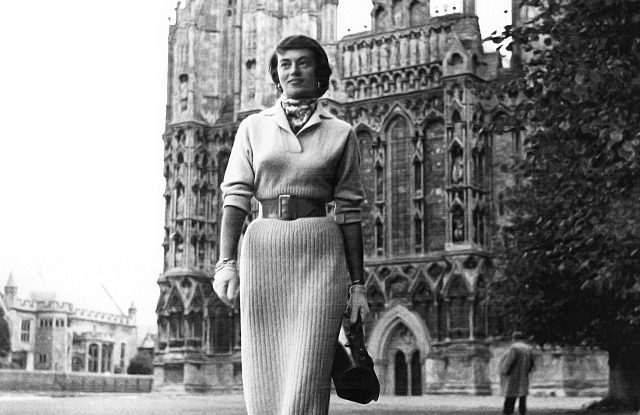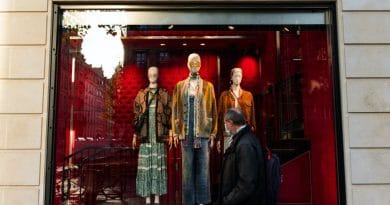Progressive Mademoiselle Editor Edith Raymond Locke Dies at 99 – WWD
Former Mademoiselle editor in chief Edith Raymond Locke died on Aug. 23 at her Los Angeles home at age 99.
Known by many as “Edie,” Locke championed boundary-breaking designers like Perry Ellis, Anne Klein, Willi Smith and Betsey Johnson early on in their careers. During her nearly two decades at Mademoiselle, she used the editorial pages to not only spotlight fashion but to broach societal issues. There, she enlisted Andy Warhol to sketch, Truman Capote to write “A Christmas Memory” and Meg Wolitzer to work as a guest editor.
In the Sixties and early Seventies, as the women’s rights movement. – or the Women’s Liberation Movement as it was then known — emerged, Locke understood how she had a pivotal role at Mademoiselle magazine. Targeting smart young women, the publication offered a wider variety of content beyond fashion and beauty tips.
Upon taking the top editorial job in 1971, Locke said she really wanted to get into the Mademoiselle reader’s head. “I’ve been thinking more about the total reader than myself. Thinking about what’s in her head and what’s out,” Locke said at the time.
Ralph Lauren said Thursday, “Edie Locke was a pioneer in women’s fashion magazines. As the editor in chief of Mademoiselle for three decades, not only was she ahead of her time in the kinds of subjects and styles she shared, but in the unique editorial staff of intelligent and independent women she led. I was fortunate to be embraced by Edie and her dedicated team early on in my career, and then later when she started producing her own TV shows.”
Lauren continued, “Even after she moved to Los Angeles, she would fly to New York to attend my runway shows. I remember her big smile and enthusiasm as I would take my walk at the end of each show. Edie loved fashion, but always through the lens of those who made it real and authentic through their personal style. She epitomized that!”
Born in Austria, Locke fled the Nazis at the age of 17, and relocated to Brooklyn to live with relatives. While working in a toothpaste factory, she learned English at night school. In time, she landed a secretarial job for Harper’s Bazaar publisher Dick Deems, and later took a merchandising editor job at Junior Bazaar, a younger offshoot of Harper’s Bazaar.
During a brief run at the advertising agency Abbott Kimball, Locke penned a fashion newsletter that attracted the attention of Mademoiselle’s Betsy Blackwell. In 1953, Blackwell poached Locke and started her on a 28-year tenure at Mademoiselle. From 1971 through 1981, Locke served as the magazine’s editor. “Carpe Diem” were words that she lived by — so much so that she wore a bracelet inscribed with that for years, according to her daughter Katie Aviv, who now wears the bracelet.
Locke was unabashed at times about Mademoiselle’s dominance in publishing, telling WWD in 1965, “We feel we own the young 20s and we’re quite smug about it…it is part of our job to be a bit shocking at times. Clothes look much better modeled on real people.”
Upon being given the top job at Mademoiselle in March 1971, Locke was clear about the publication’s more high-minded approach. She said at that time, “Never in a million years would Mademoiselle go in the Cosmopolitan direction. We’re just not that kind of magazine.”
But that was not to say that sex and women’s relationships would not be covered — just not the “I’m-the-mistress kind.” Locke said.
Wearing a midi skirt, turtleneck sweater, wide belt and a necklace that her husband made by bending forks from the Crillon Hotel, Locke told WWD in 1971, “I plan to make more noise. I really can’t wait to get into the magazine.”
Using clearer and cleaner photos that were “not so cluttered up with merchandise” was among her priorities. Locke was also integral in championing Mademoiselle’s intellectual prowess as evidenced by its publishing the early works of Capote and Joyce Carol Oates.
Designer Stan Herman described Locke as “a seminal editor in our business. She headed up the magazine that all of the intellectuals loved, when I was a young designer in the Fifties and Sixties. Mademoiselle was the best magazine of its time. It catered to those of us who were so really excited about this new burgeoning market, which was called the ‘Young Designers.’ She was the champion of the young designers from Annie Klein on — Liz Claiborne, myself, Leo Narducci, Gayle Kirkpatrick — all of the very young kids, who were making their move in the Sixties. She was sort of a mama to them.”
Locke was a close friend of the designer Anne Klein, so much so that they were “like sisters,” Herman recalled. When Klein handed over the reins of her company to Donna Karan, she did so with Locke by her side, Aviv said.
Having kept in touch with Locke after she moved to California and almost to the very end, Herman said, “She was one of the warmest women that I ever worked with in the magazine world. She embraced the community in a very elegant way. I didn’t realize that she was 99. That makes her a few years older than me.”
In line with the Women’s Liberation Movement’s request of media outlets, Mademoiselle was an early adopter of using “Ms.,” as opposed to “Miss” or “Mrs.” In January 1971, the title was used in interviews for the magazine’s “Women of the Year.” Locke told WWD three months later, “We haven’t put it into practice fully, but it’s almost certain that we will.”
Commandeering a women’s magazine in the liberating early Seventies was no small task. Locke said at that time, “It is a whole new time for people, especially women. Today’s reader wants to be shown, not told, about fashion, beauty or anything. We will stay away from ‘this is how you must look.’ We’ll make a statement but not a dictation. We won’t give them any hope, no promises.”
Locke was also cognizant of “the freedom of choice” that was evolving in fashion, during what was known as “The Me Decade.” An advocate of being able “to look and choose,” she said, “We’re not going back to that period where everyone wore the same thing. Fashion is coming down to a few basics and the rest is items.”
Surrounding herself with experienced editors and young staffers, Locke explained in 1971 that she also kept her own thoughts far ahead. “I often wish we were a daily, so that we could get news to our readers faster. Things are happening so quickly in fashion.”
Designer Jeffrey Banks said he “adored” Locke, and spoke with her periodically during her retirement. While researching his book about Perry Ellis, Banks spoke at great length with Locke about her early support and enthusiastic encouragement of Ellis, “which helped him transition from the young designer status of his early Portfolio days to full-fledged designer status.”
Banks’ admiration for Locke dates back to the 1977 Coty Awards, which was the first year that Banks was nominated. His men’s fur’s were the next-to-last event on the bill and Locke emceed the awards event. “After 31 gorgeous guys all draped in luscious pelts crossed the stage to thunderous applause, Edie, still dazzled, announced the final segment of the evening. ‘And now,’ she said, ‘the most beautiful clothes in the world — Jeffrey Banks!’” the designer said. ‘Of course, what she meant to say was Geoffrey Beene. Mr. Beene, sitting across the aisle from me in the auditorium, was not amused. I am not sure he ever forgave her. But I loved her all the more.”
Locke acted as president of the Fashion Group International for a period in the Seventies — first in New York and then in Los Angeles. Locke also chaired the American Women’s Economic Development Corporation for three years. She also headed up the Coty Awards, the precursor to the CFDA Awards, and hosted the Parsons Fashion Critics Awards Show for a number of years.
After Condé Nast, she served as editor, producer and host of “You! Magazine,” which first aired on the USA Network and then moved to Lifetime through 1984. Locke then produced and cohosted a fashion segment for “Attitudes,” a television talk show on Lifetime hosted by Linda Dano and Nancy Glass. Ralph Lauren, Oscar de la Renta, Betsey Johnson, Bill Blass, Karl Lagerfeld, Calvin Klein, Isaac Mizrahi and Karan were among the many designers who appeared on the program.
Locke was upfront about her own sense of style in an interview with WWD: “Either you are born with a fashion sense, or you develop it and stay on top of it. I had to develop mine,” she said, confessing how she had aspired to be a dentist at the age of 10. “I’m still pulling teeth in a way.”
More recently, Locke was intent on wanting to better understand the increasing racial tension across the U.S. and had her daughter order many books to better educate herself. Ever current even as she approached her centennial and her hearing waned, Locke wielded an iPhone 6 to text and show off her “flawless” emoji skills, her daughter said.
In addition to Aviv, Locke is survived by her husband, Ralph. A memorial may be planned in New York at a later date once the pandemic has ended, her daughter said.





